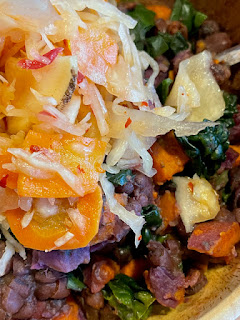Microbiotaphilic Reset Diet - A High-fiber Diet for Immune System Health
If you live with allergies, are susceptible to illness or manage autoimmune disease, increase your consumption of the fiber that naturally occurs in unprocessed plant foods. The health of the barrier that keeps undigested food and pathogens out of your bloodstream, a crucial part of a healthy immune system, requires a diet containing bountiful fiber. Here's how: a healthy immune system = healthy gut (A=B); a healthy gut = high-fiber diet (B=C); and as a result, healthy immune system = high fiber diet (A=C).
 |
| Healthy immune system = high fiber diet |
The large intestine is lined with mucous. Yep – gross, slimy mucous. Not that many years ago, alternative health practitioners viewed this mucous warily, and “treatments” such as colonics and various “cleanses” to reduce intestinal mucous were promoted to cure various ills. Thankfully mucous is now recognized for is essential role in preventing “leaky gut,” the condition where pathogens or undigested food escape from the large intestine and leak into the bloodstream. Leaky gut is a big problem for the immune system, and a healthy mucousal lining is part of your body’s natural defenses against a leaky gut.
What does mucous have to do with fiber consumption? In the absence of adequate fiber (food for the intestinal microbes), intestinal microbes eat the mucous. And when the desperately hungry microbes eat the mucousal lining, that lining is damaged. When the mucousal lining is devoured and damaged, the poop in your large intestine is more likely to leak into your bloodstream and send your immune system into a panic response. Depending on the individual’s microbiota, the immune system alarm bells may indicate a weakened immune system (more susceptible to illness) or a hypervigilant immune system that’s more susceptible to autoimmune disease.
Fiber is the primary food for the intestinal microbes, or microbiota. A healthy gut ecosystem is made up of a diverse population of well-fed microbes. We need these microbes to enjoy even modest health, and their care and feeding is the focus of the MRD. Fibrous foods aren’t digested quickly, and make it through the stomach and small intestine more or less undigested. In the large intestine, these fibrous foods feed the hungry microbes. Without fiber, the microbes in the large intestine go hungry, which can damage the intestinal walls. With abundant fiber in the diet, diversity in the gut ecosystem thrives and the intestinal walls remain resiliently intact. Fiber is healthy-gut and healthy immune system food.
In summary:
- Healthy immune system = Healthy gut (A=B)
- Healthy gut = high-fiber diet (B=C)
- Healthy immune system = high fiber diet (A=C)



Comments
Phil Jensen